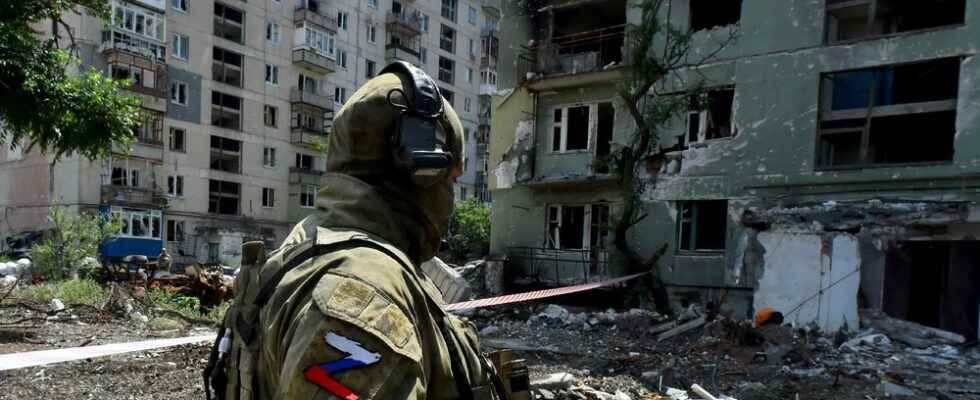The announcement has cause for concern for defenders of Ukraine. On July 30, Volodymyr Zelensky called on civilians in the Donetsk region under the control of the Ukrainian Armed Forces to evacuate the area. In fact, for several weeks now, the residential neighborhoods there have been targeted by Russian bombardments just as much as the military targets, and deaths and injuries among the population are to be deplored almost every day. “Please evacuate, urged the Ukrainian president in a video address. At this stage of the war, terror is Russia’s main weapon.”
“Many people refuse to leave… but it really needs to be done… The sooner it is done, the more people leave the Donetsk region now, the less the Russian army will have time to kill,” he said. he added, promising them “full assistance, both logistical and compensatory”. In all, just over 200,000 civilians still live in the region, including 50,000 children. However, the government has clarified that the destruction of the Donbass gas pipelines risks depriving them of heating when the harsh Ukrainian winter arrives…
However, Ukraine has not yet lost the region, from which it was amputated in 2014 following a separatist insurrection led by Moscow. This space located to the east of its territory corresponds to the oblast of Donetsk and that of Lugansk. This last region was largely lost in the first weeks of the invasion launched on February 24 by Vladimir Putin. The Russian army had then opened several fronts, in particular in the North, with the objective of taking the capital, kyiv.
Conquering the rest of Lugansk Oblast proved tedious. Unable to bring down kyiv, both politically and militarily, the Kremlin concentrated its offensive on taking Donbass. But as Lawrence Freedman, Emeritus Professor of War Studies at King’s College London, pointed out, “It took him more than two months to take the last percentages of Lugansk, while half of Donetsk still has to be conquered for achieve Putin’s minimum goals”.
A “tired” Russian army
Overall low across the country, these gains have been very expensive. Moscow had to launch a deluge of fire with its artillery – its strong point – to be able to push the front west. This strategy caused a hundred deaths a day in the Ukrainian defenses, without destroying them. It also proved to be very costly in human terms for the Russians, the areas ravaged by the shells then having to be conquered and held. Since the beginning of the war, American intelligence estimates that “more than 75,000 Russian soldiers have been killed or wounded”, indicated on July 27 an elected representative of Congress, Elissa Slotkin, and that “more than 80% of their ground forces are bogged down and tired”.
A Russian soldier on patrol in a destroyed neighborhood of Severodonetsk, eastern Ukraine, July 12, 2022. Photo taken during a press trip organized by the Russian military.
afp.com/Olga MALTSEVA
The “carpet bomb” strategy
In fact, the Russian army, forced to reconfigure its forces, declared itself in mid-July in “operational pause”. She has been progressing with difficulty ever since. And the recent use by the Ukrainians of long-range systems, such as the American Himars rocket launchers, deprives it every day of precious ammunition depots based a few tens of kilometers from the front. All this makes it even more difficult to implement its “carpet bomb” strategy. To continue to mark the Ukrainian population, Russia is therefore stepping up strikes against civilian areas – a tactic it has practiced in Syria since its involvement with the regime of Bashar al-Assad, from 2015.
Two other elements suggest that the loss of the Donbass seems unlikely in the short term. Firstly, the Ukrainian army took advantage of the time lost by the Russians in wresting the last communes of the Lugansk oblast to reinforce its lines of defense in the region, in particular in front of the twin towns of Kramatorsk and Sloviansk. The new offensive in the area could therefore turn out to be even more costly in infantry than the previous one, especially as Western arms deliveries to kyiv continue.
Secondly, for Russia, the priority now goes to the defense of the south, quickly conquered after the invasion, but where it has concentrated fewer troops. The Ukrainian army manages to progress – albeit slowly – towards the city of Kherson, aided by the destruction carried out by the Himars. “As the Ukrainian authorities stated last week, Russia is probably in the process of reallocating a significant number of its forces from the northern sector of the Donbass to southern Ukraine,” the British ministry said on Monday 1 August. defense. The end of the war is not for soon.
